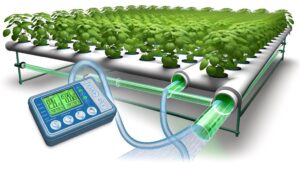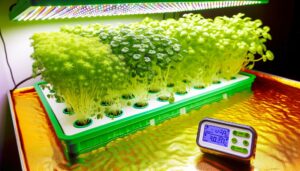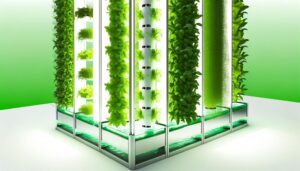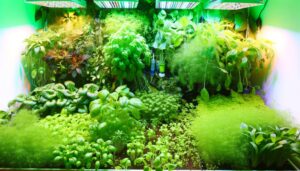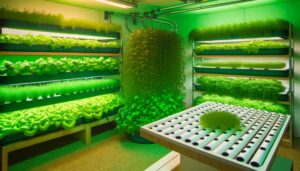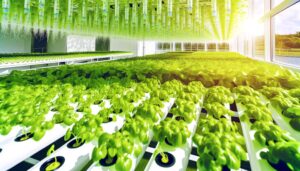What Are the 6 Requirements for Hydroponics
In hydroponics, we need to focus on six essential requirements: nutrient solutions, water quality, lighting, growing medium, temperature control, and oxygen supply. We should use a balanced nutrient mix with precise concentrations and maintain ideal pH and dissolved oxygen levels in water.
Effective lighting, mimicking natural sunlight is critical for photosynthesis. Our choice of growing medium must provide support and aeration.
Temperature control, both air and water, directly impacts growth. Finally, ample oxygen guarantees healthy roots and nutrient uptake.
Each component plays an important role in plant health and optimizing these factors can greatly enhance our hydroponic success. Discovering the nuances of each requirement can boost outcomes.
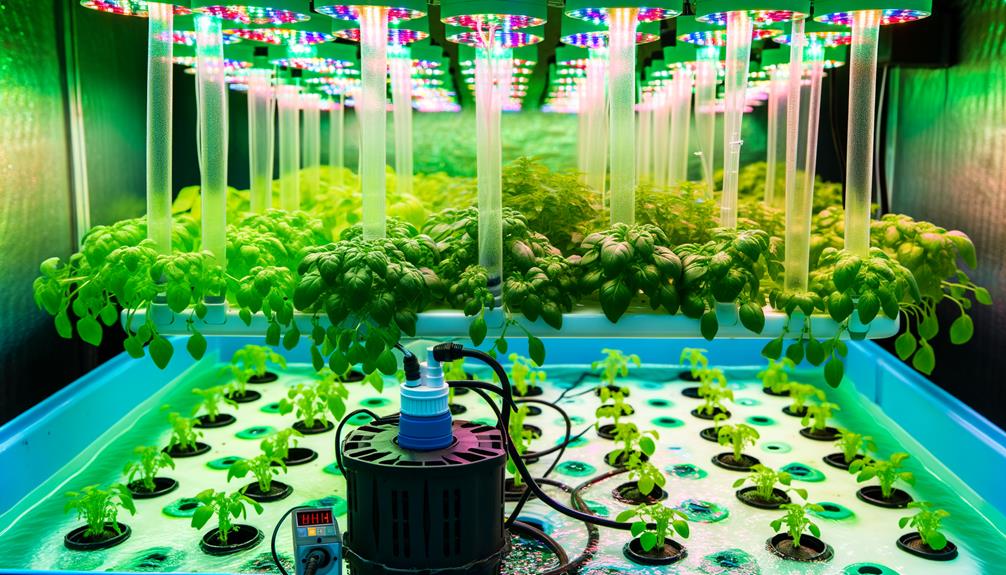
Key Takeaways
- Nutrient Solutions: Balanced nutrient mixtures with macronutrients and micronutrients are essential for plant growth and health.
- Water Quality: Contaminant-free water with ideal pH and dissolved oxygen levels supports nutrient uptake and root health.
- Lighting: Effective lighting, mimicking natural sunlight with proper intensity and photoperiod, is crucial for photosynthesis and growth.
- Growing Medium: The right medium ensures support, aeration, and efficient nutrient delivery to the plant roots.
Nutrient Solutions
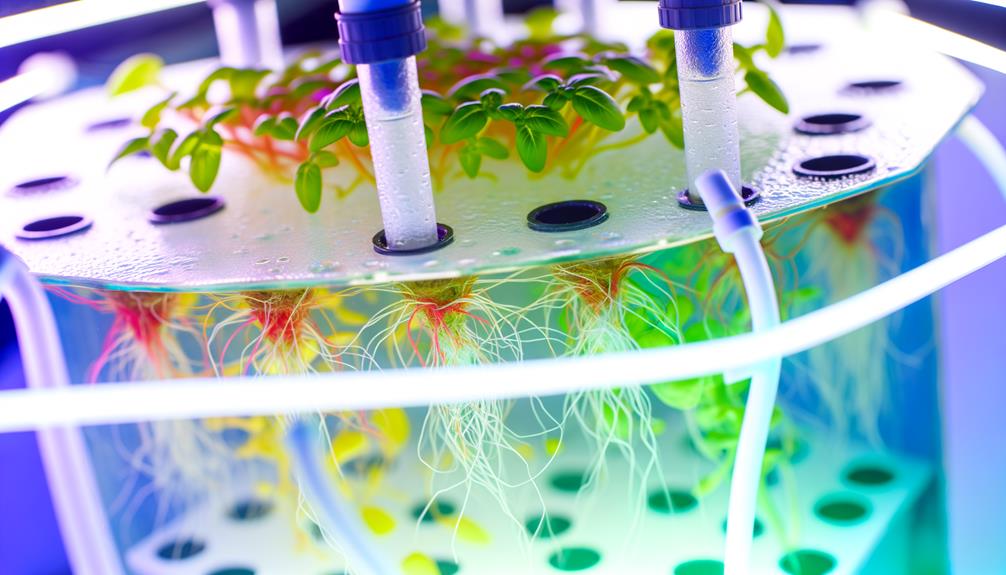
When we discuss nutrient solutions in hydroponics, we're talking about the meticulously balanced mixtures that provide plants with essential minerals and nutrients. These solutions contain macronutrients like nitrogen, phosphorus, and potassium, as well as micronutrients such as iron, manganese, and zinc.
We need to guarantee the precise concentration of each nutrient; too much or too little can inhibit plant growth or cause deficiencies. By monitoring electrical conductivity (EC) and pH levels, we can maintain prime nutrient availability.
Innovations like automated dosing systems allow us to fine-tune these parameters in real-time, enhancing plant health and yield. Our goal is to create an environment where plants can thrive without soil, achieving sustainable and efficient growth through scientific precision.
Water Quality
When we consider water quality for hydroponics, we must focus on maintaining an ideal pH level, ensuring adequate dissolved oxygen content, and sourcing contaminant-free water.
Proper pH management is essential for nutrient uptake, while sufficient oxygen levels support root health.
Ph Level Management
Maintaining ideal pH levels in hydroponic systems is essential for nutrient availability and overall plant health. We must monitor and adjust the pH to guarantee plants can efficiently absorb nutrients. The best pH range for most hydroponic crops is between 5.5 and 6.5. Deviations can cause nutrient lockout, stunting growth or causing deficiencies.
| pH Level | Impact on Plants |
|---|---|
| < 5.0 | Nutrient toxicity |
| 5.5-6.5 | Best nutrient uptake |
| 6.6-7.0 | Reduced nutrient uptake |
| 7.1-8.0 | Nutrient deficiencies |
| > 8.0 | Severe nutrient lockout |
We recommend using a digital pH meter for accuracy. Adjust pH using pH up or pH down solutions as needed. Regular checks guarantee a thriving, innovative hydroponic system.
Dissolved Oxygen Content
Guaranteeing ideal dissolved oxygen content in hydroponic systems is essential for promoting healthy root respiration and preventing root diseases.
We need to maintain dissolved oxygen levels between 5-8 ppm for optimal plant growth. Aeration techniques, such as air stones and diffusers, help achieve this by increasing oxygen exchange in nutrient solutions.
Studies show that roots deprived of sufficient oxygen can suffer from hypoxia, leading to poor nutrient uptake and increased susceptibility to pathogens. Monitoring dissolved oxygen with sensors guarantees we stay within the ideal range.
Additionally, cooler water temperatures (18-22°C) can enhance oxygen solubility. By prioritizing dissolved oxygen content, we create a robust environment that promotes vigorous root health and maximizes our hydroponic yield.
Contaminant-Free Sources
We must rigorously monitor and filter our water sources to eliminate contaminants that can compromise plant health and nutrient absorption. Contaminants such as heavy metals, pathogens, and chemical residues can disrupt the delicate balance of hydroponic systems. Utilizing advanced filtration methods like reverse osmosis and UV sterilization guarantees the purity of our water.
| Contaminant Type | Filtration Method |
|---|---|
| Heavy Metals | Reverse Osmosis |
| Pathogens | UV Sterilization |
| Chemical Residue | Activated Carbon |
| Sediments | Sediment Filters |
Lighting
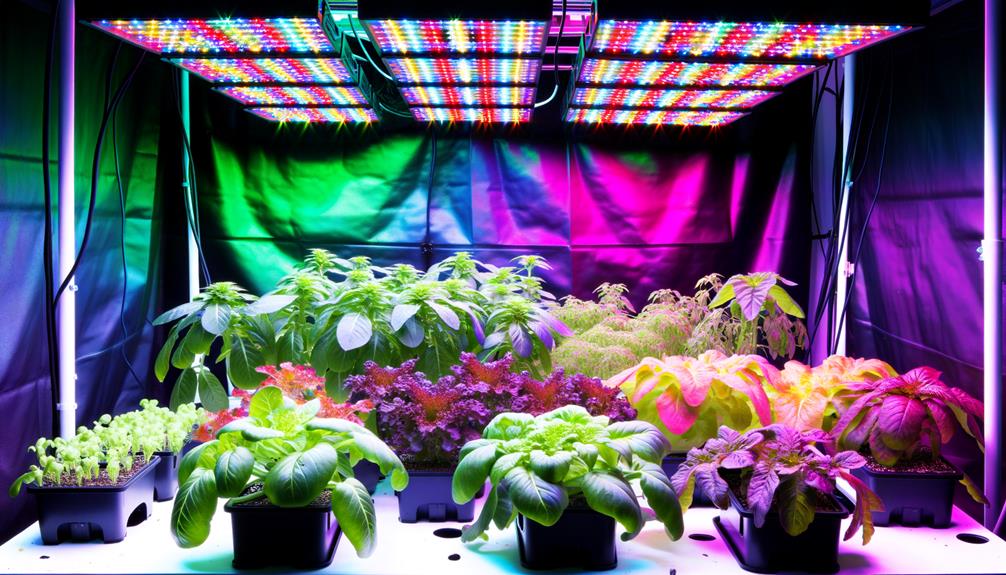
Effective lighting is vital in hydroponics as it directly influences photosynthesis and plant growth. We need to provide artificial lighting that mimics natural sunlight, focusing on the full spectrum—particularly blue and red wavelengths.
High-Intensity Discharge (HID) lamps, LED grow lights, and fluorescent lights are the most common options. LEDs are particularly efficient, offering customizable spectra and lower energy consumption.
We should guarantee that light intensity matches the specific needs of our plants, typically between 400-700 micromoles per square meter per second (µmol/m²/s).
Photoperiod control is also essential; most vegetables thrive with 16-18 hours of light daily. By optimizing our lighting setup, we can maximize growth rates, enhance yields, and improve the overall health of our hydroponic systems.
Growing Medium
Selecting the right growing medium is essential for providing plants with adequate support, aeration, and nutrient delivery in a hydroponic system. We need to evaluate several factors when choosing the best medium for our specific setup. Each option offers unique benefits tailored to different plant needs and hydroponic systems.
Coco coir: Excellent water retention and aeration, derived from coconut husks.
Perlite: Lightweight, improves drainage, and enhances root oxygenation.
Rockwool: Provides a stable pH environment and excellent moisture retention.
Clay pellets: Durable, reusable, and offer superior root aeration.
Temperature Control
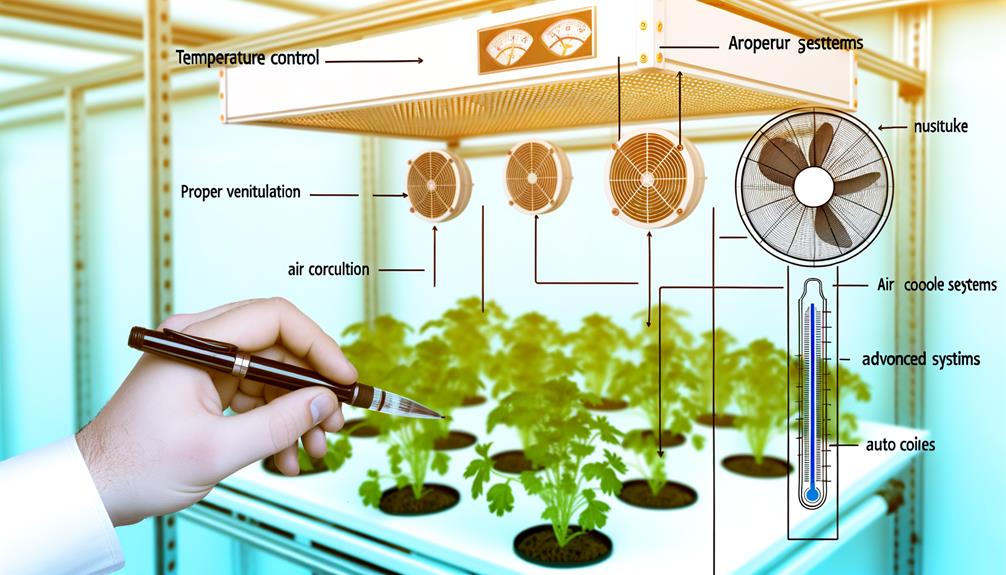
Maintaining ideal temperature control is crucial for maximizing plant growth and nutrient absorption in hydroponic systems. We need to monitor both air and water temperatures to create an ideal environment.
| Temperature Type | Ideal Range (°C) |
|---|---|
| Air Temperature | 20-25 |
| Water Temperature | 18-22 |
| Night Temperature | 15-18 |
| Day Temperature | 20-25 |
Air temperatures between 20-25°C encourage robust growth and photosynthesis, while water temperatures of 18-22°C guarantee efficient nutrient uptake. Night temperatures should be slightly cooler to mimic natural conditions, and day temperatures should return to the 20-25°C range. Using thermostats, heaters, and coolers, we can maintain these conditions, thereby promoting healthy plant development and maximizing yields.
Oxygen Supply
Let's guarantee our hydroponic systems provide adequate oxygen supply by focusing on root zone aeration, maintaining ideal dissolved oxygen levels, and employing effective oxygenation methods.
Studies show that well-oxygenated root zones greatly enhance nutrient uptake and plant health.
We can use air stones, diffusers, and venturi systems to keep oxygen levels ideal.
Root Zone Aeration
Guaranteeing adequate oxygen supply to the root zone is essential for ideal plant growth and nutrient uptake in hydroponic systems.
We need to maintain optimal root aeration to prevent root diseases and encourage healthy development.
Here are some techniques we can use:
- Air stones: These devices diffuse air into the nutrient solution, increasing oxygen availability.
- Air pumps: They continuously circulate air, guaranteeing roots receive a steady supply.
- Net pots: These allow roots to dangle directly into the nutrient-rich solution, promoting natural aeration.
Dissolved Oxygen Levels
In hydroponic systems, we must monitor dissolved oxygen levels meticulously to guarantee optimal nutrient absorption and root health. Oxygen is critical for root respiration, allowing plants to absorb nutrients effectively. Dissolved oxygen (DO) levels should typically range between 5-8 mg/L. Insufficient DO can lead to root diseases and reduced growth rates.
| DO Level (mg/L) | Root Health Impact |
|---|---|
| < 3 | High risk of root rot |
| 3-5 | Suboptimal growth |
| 5-8 | Optimal for nutrient uptake |
| 8-10 | Ideal but energy waste |
| > 10 | No additional benefit |
Maintaining the right DO levels enhances oxygen availability at the root zone, which is critical for high-yield hydroponic systems. By ensuring optimal DO, we can achieve robust plant growth and maximize productivity.
Oxygenation Methods
To maintain ideal dissolved oxygen levels in hydroponic systems, we can employ several effective oxygenation methods. These methods guarantee that roots receive adequate oxygen, promoting robust growth and nutrient uptake.
Let's consider a few:
- Air Stones: By diffusing air through porous stones, we increase oxygen distribution within the nutrient solution.
- Venturi Injectors: Utilizing the Venturi effect, these injectors mix air with water, enhancing oxygenation efficiency.
- Recirculating Systems: Constantly moving water in these systems prevents stagnation and naturally enriches the solution with oxygen.
Implementing these methods, based on system requirements and plant needs, guarantees our hydroponic setups achieve peak oxygenation levels.
Conclusion
We've covered the six essentials for hydroponics: nutrient solutions, water quality, lighting, growing medium, temperature control, and oxygen supply.
Ironically, while hydroponics seems like a high-tech farming marvel, it boils down to mastering these age-old basics.
We mightn't be planting in soil, but the principles of plant care remain rooted in time-tested science.
Let's embrace the irony and harness our detailed knowledge to grow thriving, soil-less gardens.
After all, innovation often springs from the simplest foundations.

